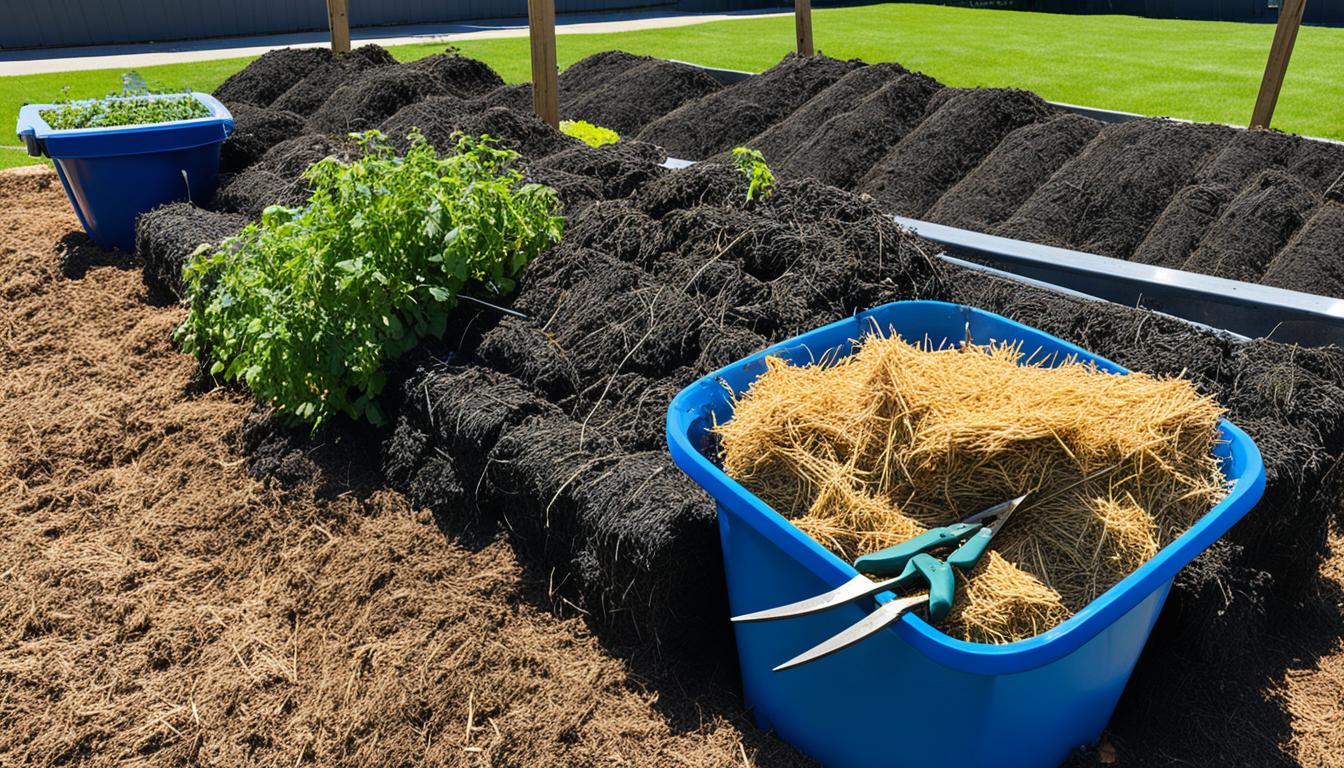Did you know red tomato mulch can boost your tomato harvest by 20%? Mulching changes the game for growing healthy tomatoes. Weeds can take over fast, but mulching keeps them down and keeps soil rich for tomatoes.
Mulching stops weeds, keeps soil moist, and builds healthier soil. It also slows disease spread and keeps your garden neat.
Great mulch for tomatoes includes marsh hay, straw, leaves, and grass clippings. Put mulch thick over the soil to block sunlight. Mulch all year to protect soil in winter and during the growing season.
This article will cover the top 10 mulching tools for a weed-free, moist, and nutrient-rich garden for your tomatoes.
Key Takeaways
- Mulching is key for healthy soil and tomato plant growth.
- Many tools, like forks and rakes, make mulching easier.
- Choosing the right mulch type and amount helps with weed control, moisture, and nutrients.
- Quality tools mean long-lasting use and easier mulching.
- Good mulching and tools lead to a weed-free tomato garden.
Introduction
Tomatoes are the top vegetable grown in the U.S., covering over 400,000 acres each year. They produce more than 14 million tons. Mulching is key for keeping these plants healthy and productive. It helps by stopping weeds, keeping soil moist, adding nutrients, and fighting diseases.
Importance of Mulching for Tomato Plants
Mulching changes the game for tomato plant care and soil health. It offers many benefits:
- Suppresses weeds, stopping them from taking nutrients and water from tomatoes
- Keeps soil moist, cutting down on watering needs
- Insulates soil, keeping the right temperature for roots
- Breaks down slowly, adding organic matter to the soil
- Stops diseases from spreading to the plant
Overview of Essential Mulching Tools
To mulch your tomato plants well, you’ll need some important tools. These include a mulching fork, garden rake, and a wheelbarrow or garden cart. You’ll also need a mulch spreader, hand trowel, mulching mats or fabric, leaf blower/vacuum, compost bin or tumbler, pruning shears, and a soil moisture meter.
Each tool has its own role in mulching. They help create a healthy, weed-free, and moist environment for your tomatoes.
“Mulching is a simple yet powerful technique that can transform your tomato garden, leading to increased yields, healthier plants, and fewer maintenance headaches.”
1. Mulching Fork
A mulching fork is great for mixing organic mulch into garden beds. It has a strong forked head and a long handle. This makes it perfect for spreading mulch evenly around plants like tomatoes.
Key Features
What makes a good mulching fork?
- Forked head design for easy mulch handling
- Long, ergonomic handle for comfort and control
- Durable construction with stainless steel or forged-steel tines
- Right size and weight for the user and garden
Benefits for Tomato Plants
Using a mulching fork helps tomato plants a lot:
- It spreads mulch evenly around the plants.
- Working the mulch into the soil improves aeration. This helps roots grow and plants absorb nutrients better.
- The mulch layer keeps soil moist, so plants don’t need water as often.
- It stops weeds from growing by blocking sunlight and preventing them from getting nutrients and water.
With a mulching fork, you can keep a healthy mulch layer around your tomatoes. This makes their growing conditions better and helps them grow strong and produce well.
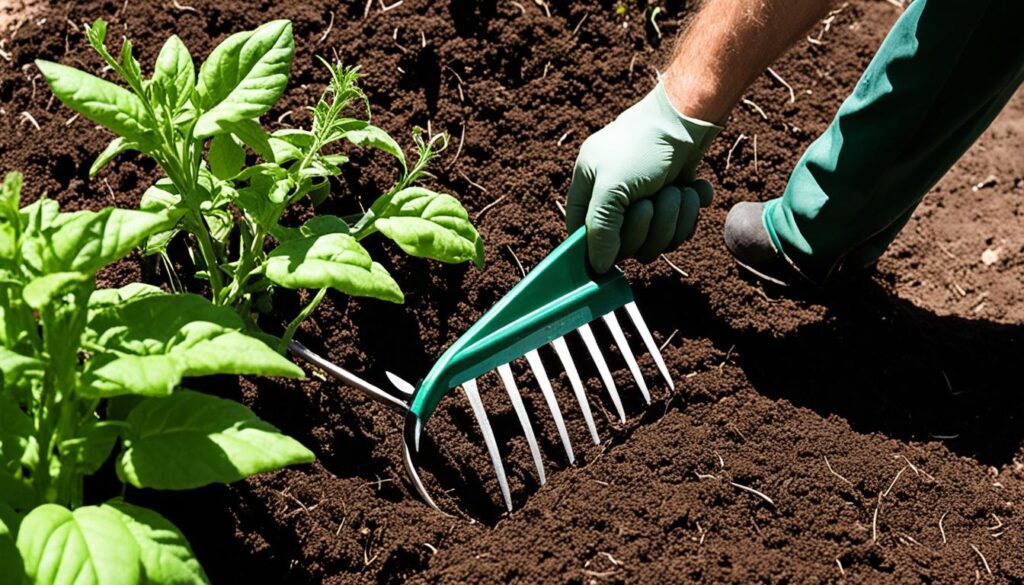
2. Garden Rake
A garden rake is key for mulching your tomato plants. There are many types of garden rakes, each with special features. Knowing about them helps you pick the best one for mulching.
Types of Garden Rakes
- Shrub Rakes – These rakes have a plastic head and a light aluminum handle. They are easy to move between plants. The heads are about 8 inches wide, perfect for small spaces.
- Leaf Rakes – Plastic leaf rakes can be up to 30 inches wide. Metal ones vary in width and some adjust to fit different needs.
- Thatch Rakes – These rakes have one or two-sided blades. They are great for removing debris and preparing the soil.
- Garden Rakes – You can find flat-head and bowhead garden rakes. Each is designed for specific tasks.
Using a Garden Rake for Mulching
A metal garden rake is great for mulching tomatoes. Its tines spread and smooth mulch evenly. This ensures good soil contact and coverage, which is key for mulching. The rake also helps mix mulch into the soil, enriching it for your tomatoes.
For more on choosing the right garden rake, see this guide from Garden Gate Magazine. The Gardening Tools Guide from The Old Farmer’s Almanac and the Long-Handled Tools from Grange Co-op are also great resources.
3. Wheelbarrow or Garden Cart
Using a wheelbarrow or garden cart is key for moving mulch in your tomato garden. These tools make it easy to carry heavy mulch, saving you time and effort. You won’t have to carry it by hand.
Choosing the Right Wheelbarrow or Cart
When picking a wheelbarrow or garden cart, look for what makes gardening easier. Choose one with a strong frame and big, tough tires for rough paths. This way, you can carry lots of mulch easily.
The Garden Star wheelbarrow is great for its 300-pound capacity and 5-cubic-foot size. The Best Budget wheelbarrow is cheaper but still has a 4-cubic-foot capacity. For heavy-duty needs, the Best for Gardening wheelbarrow has a 7-cubic-foot capacity and strong steel.
Benefits for Transporting Mulch
Wheelbarrows and garden carts have many benefits for moving mulch. They let you spread mulch over more of your garden easily. Garden carts are great because they move well on rough paths.
Buying a good wheelbarrow or cart can also protect your back. These tools make moving heavy loads easier, so you don’t get tired.
“A wheelbarrow or garden cart is a must-have for gardeners. It helps me cover more ground and keeps me from getting tired from carrying mulch.”
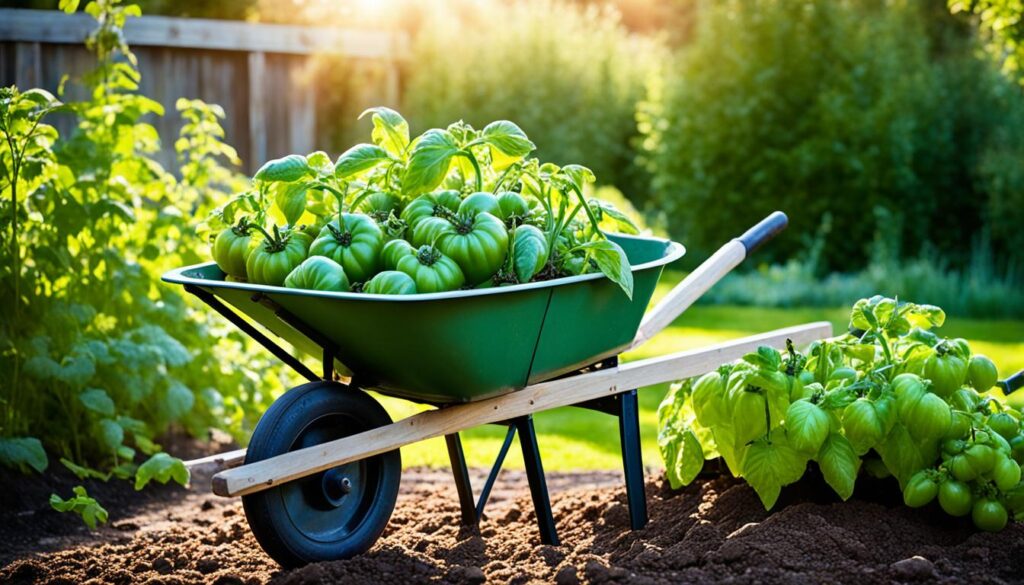
Choosing between a wheelbarrow or a garden cart can really help your tomato garden. The right tool makes gardening easier and less hard on your body. You’ll have a healthier garden with less effort.
4. Mulch Spreader
For big tomato gardens, a mulch spreader is a must-have. It makes spreading mulch easy and fast. You can choose from manual or motorized models. They have features like adjustable flow control and variable spread width.
With a mulch spreader, you can spread mulch evenly across your garden beds quickly. This saves you time and effort compared to spreading it by hand.
Types of Mulch Spreaders
There are many types of mulch spreaders for different gardening needs. Here are some common ones:
- Push-behind spreaders: These are manual and you push them along your garden rows. They have a hopper that spreads mulch as you go.
- Broadcast spreaders: These are motorized and use a spinning disc to spread mulch in a wide pattern. You can drive or walk behind them.
- Tow-behind spreaders: These are pulled by a lawn tractor or ATV. They are great for big jobs and cover a lot of ground.
Efficiency and Ease of Use
Using a mulch spreader has many benefits over spreading mulch by hand. It spreads evenly, which helps control weeds and keeps moisture in the soil. You can adjust the settings to fit your needs.
It takes less time and effort to spread mulch with a spreader, especially for big gardens or if you have limited mobility. With the right spreader, you can get professional-looking results fast.
| Mulch Spreader Feature | Benefit for Tomato Gardening |
|---|---|
| Adjustable flow control | Allows customization of mulch application rate for optimal coverage |
| Variable spread width | Enables efficient, even distribution of mulch across garden beds |
| Motorized models | Reduce physical effort and save time for larger tomato gardens |
Getting a good mulch spreader can really change the game for tomato growers. These tools are fast and precise. They help your tomato plants get the right amount of mulch for the best growth and production.
5. Hand Trowel
A durable hand trowel is key for small tomato plants or hard spots. Choose one made of strong, rust-proof materials. It should last a long time. A good hand trowel lets gardeners dig small holes or trenches easily. This is for putting and spreading mulch around tomato plants.
Selecting a Durable Hand Trowel
The best garden hand trowels cost about $14.99. Top picks have carbon-steel build with sharp edges and tips. They get ratings of 4.5 out of 5 or more. For example, the Niwaki Moku trowel and the Wilkinson Sword Stainless Steel Hand Trowel (with a 10-year warranty) are favorites among gardeners.
Small-Scale Mulching Benefits
Using a hand trowel for mulching covers soil well, even in tight spots around tomato plants. It lets gardeners put the right amount of mulch exactly where it’s needed. A durable hand trowel is great for making the best mulching conditions for tomatoes.
“A high-quality hand trowel is an indispensable tool for small-scale mulching around tomato plants. Its precision and durability make it a must-have for any tomato gardener.”
6. Mulching Mats or Fabric
Mulching mats and fabrics are great for tomato plants instead of loose mulches. They lay right on the soil, stopping weeds and keeping soil moist. You can find mulching mats in many types like woven fabrics, perforated plastic sheets, and interlocking rubber or foam tiles.
Types of Mulching Mats
There are many mulching mats to pick from. Woven mulching fabric lets water and air get to the soil but stops weeds. Perforated plastic sheets also help keep moisture in and weeds out. For something that lasts longer, try interlocking rubber or foam tiles for a mulching mat system.
Application and Benefits
Putting mulching mats down is easy and keeps weeds away from tomato plants. These mats let water and air get to the soil and keep moisture in. This means better plant growth, more fruit, and less weed trouble.
Studies show that mulching mats and fabrics keep soil temperatures steady and save time. For instance, plastic mulch takes a lot of work but landscape fabric is easier to put down but harder to plant through. Using mulching mats can really help tomato growers with soil health and make gardening easier.
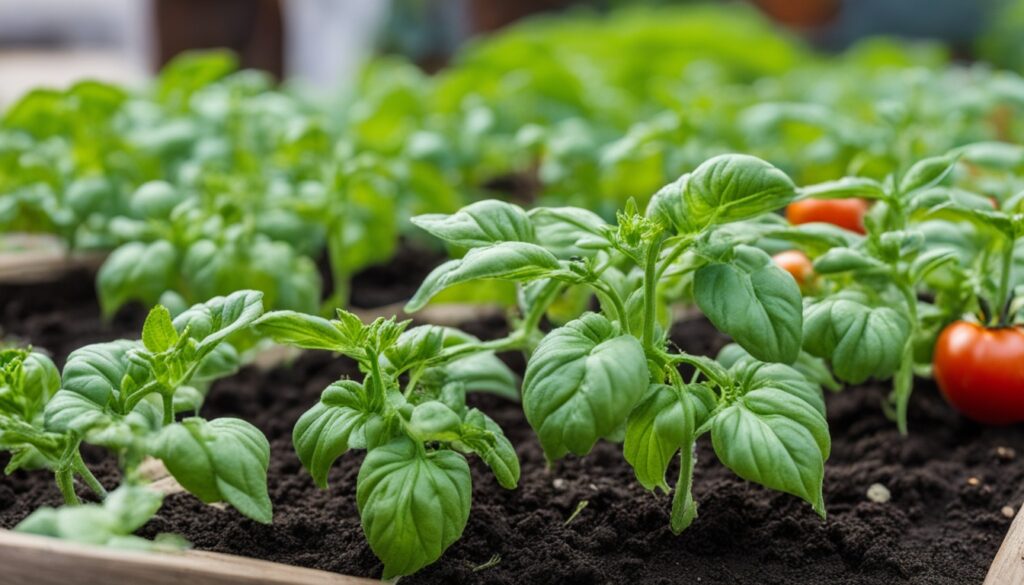
“Laying plastic mulch was time-consuming and difficult, while laying landscape fabric was quicker but planting into it was more challenging.”
7. Leaf Blower/Vacuum
A leaf blower or vacuum is great for managing mulch in your tomato garden. These tools can pick up leaves, grass clippings, and more. Then, you can use this material as mulch around your tomato plants.
Using a Leaf Blower for Mulching
A leaf blower’s strong air flow makes spreading mulch easy. It blows the material evenly over the soil. This keeps your tomato plants’ roots safe from extreme temperatures and losing moisture.
There are many leaf blower models available. You can choose from cordless, gas-powered, or corded electric ones. Cordless blowers are easy to move around. Gas and corded models work better for big areas. When picking a blower, think about airspeed and air volume to get the best coverage.
Benefits and Precautions
Leaf blowers are good for your tomato plants. They spread mulch evenly, keeping soil moist, stopping weeds, and adding nutrients as it breaks down. But, be careful not to hurt the plants with the high-speed air. Keep the blower away from the plants and adjust the power.
For the best results, choose a blower with variable speed. This lets you control how much air comes out. Also, look for a blower that can shred or mulch big pieces into smaller ones.
| Leaf Blower Model | RRP | Our Rating | Key Features |
|---|---|---|---|
| Worx WG543E LeafJet | £179.99 | 5/5 | Best value, cordless |
| Husqvarna Aspire B8X-P4A | £229 (with battery and charger), £129 bare tool | 4.8/5 | Best for ease of use |
| Makita DUB186Z 18V cordless | £179.99 | 4.8/5 | Best for performance |
| Einhell GP-LB 36/210 Li Turbo | £219.90 (with battery and charger starter kit) | 4.8/5 | Best for features |
A leaf blower is a great tool for your tomato garden. It helps keep the soil healthy and your plants looking good. By knowing how to use it right, you can make your tomatoes thrive.
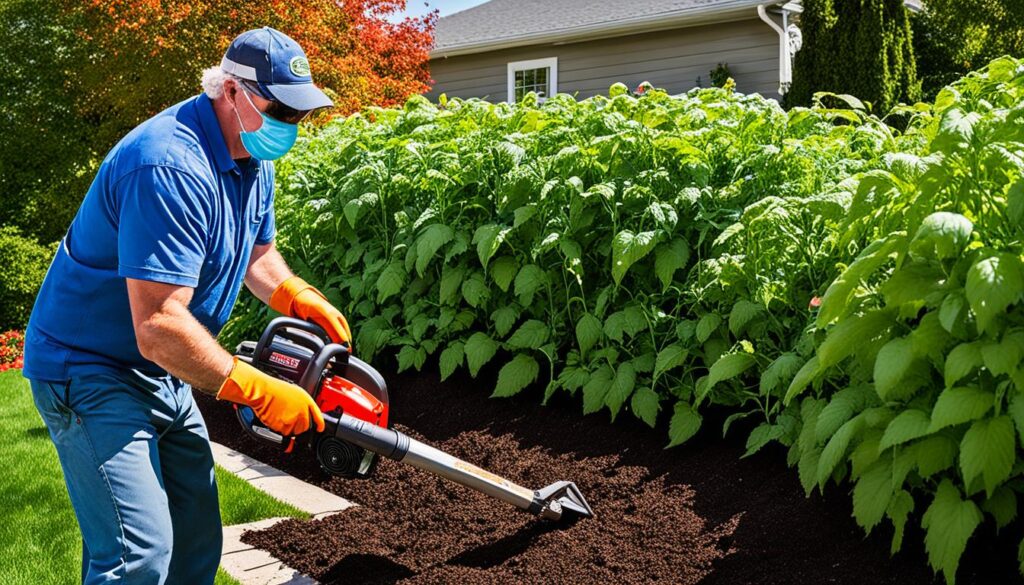
8. Compost Bin or Tumbler
Composting is great for tomato gardeners to make their own mulch. A compost bin or compost tumbler helps break down organic waste into a nutrient-rich soil amendment. This homemade compost can be used as mulch around tomato plants. It helps with weed control and gives plants essential nutrients.
Using compost as mulch also improves soil structure, keeps moisture in, and boosts plant health for tomatoes.
Making Mulch from Compost
Making mulch from compost is easy and good for your tomato plants. Composting turns kitchen scraps, yard trimmings, and other plant matter into a rich, dark humus. Spread this compost around your tomato plants to keep moisture in and stop weeds.
- Compost piles are easy to set up.
- Compost tumblers make turning easier.
- Compost piles take longer to produce compost.
- Compost piles can lose nutrients in heavy rain, unlike tumblers.
Benefits of Using Compost as Mulch
Using compost as mulch has many benefits:
- Improved soil structure: Compost makes heavy clay soils easier to work with and improves drainage in sandy soils, helping tomato roots grow well.
- Enhanced moisture retention: Compost keeps soil moist, so you water your tomatoes less often.
- Weed suppression: Compost mulch stops weed seeds from growing, giving your tomatoes more room and resources.
- Nutrient-rich growth: As compost breaks down, it gives your tomato plants essential nutrients like nitrogen, phosphorus, and potassium.
“Compost tumblers are great for small spaces because they’re critter and smell-free. Vermicomposting makes a special fertilizer through worm castings.”
Adding compost as mulch around your tomatoes makes a great growing environment. It supports healthy plants and big harvests.
9. Pruning Shears
Pruning shears are great for more than just trimming plants. They help make mulch for your tomato plants too. By cutting down big organic stuff like leaves and twigs, you make mulch that breaks down fast.
Pruning Shears for Mulch Preparation
It’s key to use pruning shears right for making mulch. Keep the blades sharp and clean to avoid extra work and damage. Also, cut carefully to protect your hands and the shears.
Best Practices for Using Pruning Shears
- Make sure your pruning shears are sharp and clean. Sharpen and clean them often to keep them in good shape.
- Choose the right size shears for the job. Big branches need heavy-duty loppers, while small ones use lightweight pruners.
- Cut with precision, making clean cuts instead of sawing or forcing the shears.
- Wear gloves to protect your hands from cuts and scrapes.
- Throw away big or woody pieces that can’t be made into mulch.
Follow these tips for making great mulch with pruning shears. It will help your tomato plants stay healthy. For more info, check out these resources: Reviewed.com, Sunlight Grow, and Fine Gardening.
10. Soil Moisture Meter
A soil moisture meter is key for keeping tomato plants healthy and productive. It lets you check soil moisture levels precisely. This ensures your mulching keeps your tomato plants well-hydrated.
Monitoring Soil Moisture Levels
Soil moisture meters come in many styles, like analog and digital. They give you insights into your soil’s moisture. By putting the meter’s probe under the mulch, you can see if your plants need water or if they’re just right.
But, remember that soil salinity can mess with some meters, making them show wrong moisture levels. To fix this, calibrate your meter after using fertilizers. Salts can change how the meter reads.
Ensuring Effective Mulching
Using a soil moisture meter with mulching helps your tomato plants stay hydrated. It lets you know when to add more mulch or adjust watering. This keeps your tomatoes in perfect condition.
Getting a good soil moisture meter, like the XLUX T10 or the REOTEMP Compost Moisture Meter, is key. It helps you make sure your mulching works well for your tomatoes. With this tool, you won’t have to guess about soil moisture levels. Your tomatoes will thrive all season.
“Soil salinity can affect the readings of soil moisture meters, causing them to register artificially high moisture levels in the presence of salts in the soil.”
Conclusion
The best tools for mulching tomato plants include a mulching fork, garden rake, and more. These tools help put a protective layer of mulch around tomato plants. This helps with healthier soil, fewer weeds, and better growth and yields.
Recap of Top Mulching Tools
Tools like the mulching fork and garden rake make mulching easy for tomato plants. A wheelbarrow or cart helps move mulch. A mulch spreader spreads it evenly. Hand trowels, mulching mats, and leaf blowers make small tasks easier.
Encouragement to Use Mulching Tools
Using these tools is key for a great vegetable garden. Mulching helps your tomato plants stay healthy and productive. This leads to more harvests every season.
Final Tips for Healthy Tomato Plants
Proper mulching is part of taking care of tomatoes. Also, use staking and pruning, and watch for pests and diseases. With these tools and practices, your tomato garden will thrive.
FAQ
What are the key benefits of mulching for tomato plants?
Mulching keeps weeds away and holds moisture in the soil. It also makes the soil healthier, slows down diseases, and keeps the garden tidy. It’s key for growing healthy tomatoes and a great garden.
What are the best mulch materials for tomato plants?
Great mulch for tomatoes includes marsh hay, straw, leaves, and grass clippings. These materials create a rich layer that protects the soil and helps plants grow.
How thick should the mulch layer be around tomato plants?
Put mulch on thick to cover the soil and block sunlight. This makes mulching work best for tomatoes.
What are some essential mulching tools for tomato gardeners?
Important tools for mulching are a mulching fork, garden rake, wheelbarrow or cart, mulch spreader, hand trowel, mulching mats, leaf blower, compost bin, pruning shears, and soil moisture meter.
How can a mulching fork benefit tomato plants?
A mulching fork helps spread and mix mulch into the soil evenly. It stops weeds, aerates the soil, and keeps moisture in.
What are the advantages of using a garden rake for mulching tomatoes?
A metal garden rake spreads and smooths mulch evenly. Its tines mix the mulch into the soil, ensuring good coverage and soil contact.
How can a wheelbarrow or garden cart improve mulching efficiency?
A wheelbarrow or cart makes moving mulch easier, saving time and effort. It helps cover more of the tomato patch quickly.
What are the benefits of a mulch spreader for tomato gardens?
Mulch spreaders, manual or motorized, spread mulch evenly fast. They save time and effort, ensuring good weed control and moisture in the soil.
How can a hand trowel be useful for mulching around tomato plants?
A hand trowel is great for placing and spreading mulch around tomatoes. It’s perfect for tight spaces, ensuring every plant gets full coverage and protection.
What are the advantages of using mulching mats or fabric for tomatoes?
Mulching mats and fabrics create a weed-free layer quickly. They let water and air into the soil, helping tomatoes grow well.
Source Links
Tomato Answers
Tomato Answers
Tomato Answers
Tomato Answers
Tomato Answers
Tomato Answers
Tomato Answers
Tomato Answers
Tomato Answers
Tomato Answers
Tomato Answers
Tomato Answers
Tomato Answers
Tomato Answers
Tomato Answers
Tomato Answers
Tomato Answers
Tomato Answers
Tomato Answers
Tomato Answers
Tomato Answers
Tomato Answers
Tomato Answers
Tomato Answers
Tomato Answers
Tomato Answers
Tomato Answers
Tomato Answers
Tomato Answers
Tomato Answers
Tomato Answers
Tomato Answers
Tomato Answers
Tomato Answers
Tomato Answers
Tomato Answers
Tomato Answers
Tomato Answers
Tomato Answers
Tomato Answers
Tomato Answers
Tomato Answers
Tomato Answers
Tomato Answers
Tomato Answers
Tomato Answers
Tomato Answers
Tomato Answers
Tomato Answers
Tomato Answers
Tomato Answers
Tomato Answers
Tomato Answers
Tomato Answers
Tomato Answers
Tomato Answers
Tomato Answers
Tomato Answers
Tomato Answers
Tomato Answers
Tomato Answers
Tomato Answers
Tomato Answers
Tomato Answers
Tomato Answers
Tomato Answers
Tomato Answers
Tomato Answers
Tomato Answers
Tomato Answers
Tomato Answers
Tomato Answers
Tomato Answers
Tomato Answers
Tomato Answers
Tomato Answers
Tomato Answers
Tomato Answers
Tomato Answers
Tomato Answers
Tomato Answers
Tomato Answers
Tomato Answers
Tomato Answers
Tomato Answers
Tomato Answers
Tomato Answers
Tomato Answers
Tomato Answers
Tomato Answers
Tomato Answers
Tomato Answers
Tomato Answers
Tomato Answers
Tomato Answers
Tomato Answers
Tomato Answers
Tomato Answers
Tomato Answers
Tomato Answers
Tomato Answers
Tomato Answers
Tomato Answers
Tomato Answers
Tomato Answers
Tomato Answers
Tomato Answers
Tomato Answers
Tomato Answers
Tomato Answers
Tomato Answers
Tomato Answers
Tomato Answers
Tomato Answers
Tomato Answers
Tomato Answers
Tomato Answers
Tomato Answers
Tomato Answers
Tomato Answers
Tomato Answers
Tomato Answers
Tomato Answers
Tomato Answers
Tomato Answers
Tomato Answers
Tomato Answers
Tomato Answers
Tomato Answers
Tomato Answers
Tomato Answers
Tomato Answers
Tomato Answers
Tomato Answers
Tomato Answers
Tomato Answers
Tomato Answers
Tomato Answers
Tomato Answers
Tomato Answers
Tomato Answers
Tomato Answers
Tomato Answers
Tomato Answers
Tomato Answers
Tomato Answers
Tomato Answers
Tomato Answers
Tomato Answers
Tomato Answers
Tomato Answers
Tomato Answers
Tomato Answers
Tomato Answers
Tomato Answers
Tomato Answers
Tomato Answers
Tomato Answers
Tomato Answers
Tomato Answers
Tomato Answers
Tomato Answers
Tomato Answers
Tomato Answers
Tomato Answers
Tomato Answers
Tomato Answers
Tomato Answers
Tomato Answers
Tomato Answers
Tomato Answers
Tomato Answers
Tomato Answers
Tomato Answers
Tomato Answers
Tomato Answers
Tomato Answers
Tomato Answers
Tomato Answers
Tomato Answers
Tomato Answers
Tomato Answers
Tomato Answers
Tomato Answers
Tomato Answers
Tomato Answers
Tomato Answers
Tomato Answers
Tomato Answers
Tomato Answers
Tomato Answers
Tomato Answers
Tomato Answers
Tomato Answers
Tomato Answers
Tomato Answers
Tomato Answers
Tomato Answers
Tomato Answers
Tomato Answers
Tomato Answers
Tomato Answers
Tomato Answers
Tomato Answers
Tomato Answers
Tomato Answers
Tomato Answers
Tomato Answers
Tomato Answers
Tomato Answers
Tomato Answers
Tomato Answers
Tomato Answers
Tomato Answers
Tomato Answers
Tomato Answers
Tomato Answers
Tomato Answers
Tomato Answers
Tomato Answers
Tomato Answers
Tomato Answers
Tomato Answers
Tomato Answers
Tomato Answers
Tomato Answers
Tomato Answers
Tomato Answers
Tomato Answers
Tomato Answers
Tomato Answers
Tomato Answers
Tomato Answers
Tomato Answers
Tomato Answers
Tomato Answers
Tomato Answers
Tomato Answers
Tomato Answers
Tomato Answers
Tomato Answers
Tomato Answers
Tomato Answers
Tomato Answers
Tomato Answers
Tomato Answers
Tomato Answers
Tomato Answers
Tomato Answers
Tomato Answers
Tomato Answers
Tomato Answers
Tomato Answers
Tomato Answers
Tomato Answers
Tomato Answers
Tomato Answers
Tomato Answers
Tomato Answers
Tomato Answers
Tomato Answers
Tomato Answers
Tomato Answers
Tomato Answers
Tomato Answers
Tomato Answers
Tomato Answers
Tomato Answers
Tomato Answers
Tomato Answers
Tomato Answers
Tomato Answers
Tomato Answers
Tomato Answers
Tomato Answers
Tomato Answers
Tomato Answers
Tomato Answers
Tomato Answers
Tomato Answers
Tomato Answers
Tomato Answers
Tomato Answers
Tomato Answers
Tomato Answers
Tomato Answers
Tomato Answers
Tomato Answers
Tomato Answers
Tomato Answers
Tomato Answers
Tomato Answers
Tomato Answers
Tomato Answers
Tomato Answers
Tomato Answers
Tomato Answers
Tomato Answers
Tomato Answers
Tomato Answers
Tomato Answers
Tomato Answers
Tomato Answers
Tomato Answers
Tomato Answers
Tomato Answers
